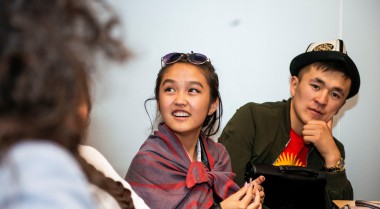
#Financing4Peacebuilding: Civil Society Statement to the Peacebuilding Commission
GPPAC's Senior UN Policy and Advocacy Advisor, Marina Kumskova, on behalf of civil society shared the following written submission with the Peacebuilding Commission.
(Shortened version for delivery)
Thank You, Chair.
Excellencies, Ladies and Gentlemen,
On behalf of GPPAC, Life & Peace Institute (LPI), Conducive Spaces for Peace, CSPPS and civil society organisations engaged in the discussions ahead of the 2022 High-Level Meeting on Financing for Peacebuilding, I would like to thank the Permanent Mission of Egypt for providing us with the opportunity to briefly address today’s session.
We believe there is a need to increase both the quantity of financial contributions to peacebuilding, but also the quality of financing that impacts the ability of actors to utilise existing and additional resources effectively and with impact.
One way of increasing quality financing is to localise peacebuilding and sustaining peace agenda. One important lesson from our GPPAC’s current engagement in Sudan, Somalia, and Mozambique is that the sustainability of peace is only possible where there
exists an enabling and supportive environment for local peacebuilding.
We applaud the recent political recognition of local peacebuilders as critical agents in peacebuilding and sustaining peace. To operationalize such a policy commitment in practice, the upcoming High-Level Meeting should result in a commitment to explore innovative approaches that channel resources to local peacebuilders.
We recommend Member States to consider the following three approaches:
1. Integrate principles of authentic partnership into funding modalities by using these principles as selection criteria for intermediary partners and ensuring that intermediary partners also apply these principles in their work with local peacebuilders.
One example of such partnership is PBF’s support of a joint GPPAC-FTI project, “Cameras in Hands,” in Kyrgyzstan. In this project, effective designation of roles and the process of co-designing between the organisations maximised the effectiveness of the project.
Further, donors should move away from the idea of a purely financial partnership and recognize that donors and peacebuilders are equally interested in a project’s success and work to bring their comparative advantages together. The partnership between the PBF, LPI, and Somalia Peace Line (SPL) within the GYPI in Somalia, for example, has seen a high degree of collaboration at all stages of the process and proved beneficial for all parties.
2. Explore avenues to provide direct funding to local peacebuilding networks, including through embassies of bilateral donors.
Some embassies of bilateral donors, including but not limited to Sweden, the UK, Netherlands, Canada, and Ireland, provide direct funding for local peacebuilders. Embassies often support organisations in refining proposals and connecting with critical
stakeholders at national, regional and global levels. Local peacebuilders often see this as a form of support rather than control.
3. Engage local peacebuilders directly in decision- and grant-making.
When donors develop their approaches to funding peacebuilding action, they rarely consult with local peacebuilders directly. This may be one challenge we face as the international community prepares for the upcoming High-Level Meeting. The absence of local
peacebuilders can lead to inaccurate analysis and misinformed priorities and the lack of sustainable impact at the country level.
One good practice is the Women’s Peace and Humanitarian Fund (WPHF) that has four civil society organisations on its board. This composition allows civil society to inform funding priorities and decisions of the Fund. This model can be replicated in processes leading up to the 2022 High-Level Meeting.
In conclusion, it is essential that the peacebuilding community moves away from rhetoric and focuses on the implementation of peacebuilding and sustaining peace. This must be done in a way that engages local peacebuilders as recognised partners and stakeholders during the High-Level Meeting and the follow-up action.
We thank you for your attention.
Read the full statement here.
---
For more information about Member States recommendations regarding Financing for Peacebuilding raised during the PBC 2022 Annual Meeting, please check our the table here>>> (Courtesy of GPPAC's PBC Monitoring)


